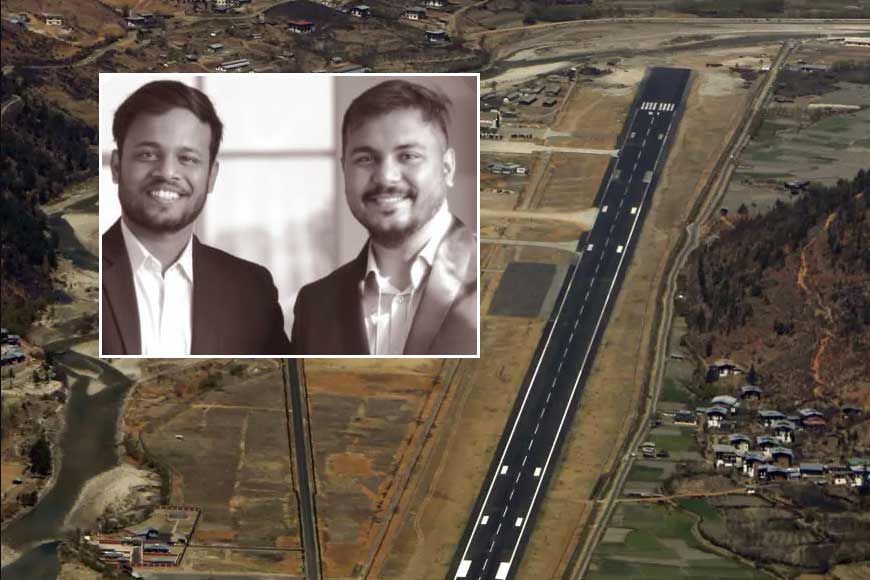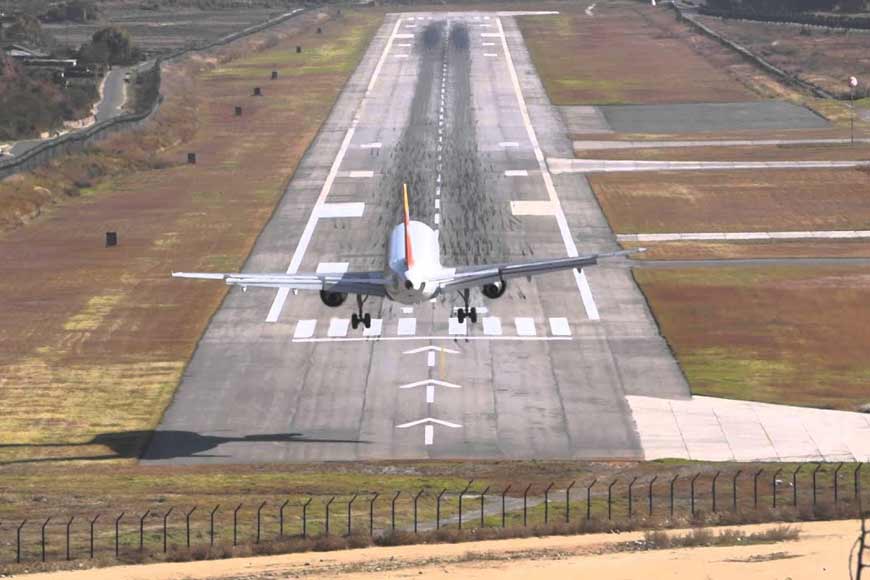Architects Ayan Roy and Soumyadeep Das to design Bhutan's Paro Airport

Have you heard the names of architects Ayan Roy and Soumyadeep Das? Well, they have made us proud. The state government has already assigned the team to design a 40-feet iconic gate at the entrance of the Information Technology (IT) hub in Salt Lake Sector V. The architects are both alumni of Indian Institute of Engineering Science and Technology, Shibpur, and co-founders of the architectural firm, VBRIDGE. Right from inception of the iconic gate, the start-up company has been in the news for its innovative projects like the model village designed in Jaugram, COVID street art at Konnagar (in 2020), 3D illusion art guard rails in New Town and COVID hospitals across the country. The architecture studio is now all set to create another massive ripple by getting the design credentials of Paro airport, Bhutan.
Ayan did his schooling from Belur Boys High School and H.M (Hind Motor) Education Centre. Soumyadeep Das studied at Mahesh Sri Ramkrishna Ashram Vidyalaya (Higher Secondary). After school, both of them joined the Indian Institute of Engineering Science and Technology (IIEST), Shibpur (erstwhile Bengal Engineering College and formerly Bengal Engineering and Science University) for their Bachelor’s degree in architecture. Both were brilliant students and received prestigious awards for their innovative projects. In 2016, Soumyadeep was the national first rank holder in CII-IGBC (Indian Green Building Council) Design Competition, 2016, issued by Council of Architecture, India, in 2017 he received the National Awards for Excellence in Architectural Thesis (NAET), issued by the Council of Architecture, India, etc. However, both Roy and Das were reluctant to take up regular jobs. Instead, they were determined to do something on their own.
VBRIDGE was officially formed in 2019, although the studio started its journey earlier when both the founders, Ayan Roy and Soumyodeep Das were still pursuing their architecture course in IIEST. The name of the start-up was derived from We BRIDGE the gap, which turned WeBRIDGE and eventually to VBRIDGE. Team VBRIDGE started with a motto to bridge the gap between architects and society, professionals, clients, users, students – in other words, the entire community with the design world. The firm is also collaborating with several government bodies and non-profit organizations and implementing ingenious designs.

In March 2020, a nationwide lockdown was imposed to curb the spread of novel coronavirus in the country. Within three months of the outbreak, the designer-architect duo, who had just started VBRIDGE, came up with an inventive initiative to encourage social distancing in the rural areas of Bengal through a 1500-feet-long street artwork in ‘Wireless Para’ in Konnangar, Hooghly district. A video went viral on the internet that showed the design -- a circular maze at the centre, from where variously patterned white geometric shapes branched out, and intercepted with shapes and patterns, guiding people to maintain their distance.
Aesthetically, geometric shapes tend to have a better visual effect than other patterns. Keeping that in mind, the founders stuck to the adage, ‘Every line in architecture matters,’ when creating the motif. Nearly 30 people came together to have the art executed in only two days, right before Cyclone Amphan hit parts of Bengal.
On International Engineers’ Day on September 22 this year, VBRIDGE hosted its first edition of VIVACE (VBRIDGE’s Integrated Vision, Architecture, Conclave and Exhibition). The exhibition and conclave aimed at discussing the future of architecture in Bengal and the rest of India and were attended by professionals, industrialists, top government officials and industry experts. It was at the conclave that the founders announced the news of their company bagging the design credentials for Paro Airport, Bhutan and also designing the iconic gate at Sector V, Salt Lake. This is seen as a huge milestone in the start-up’s journey.
Work on the 12 meter (40-feet) iconic gate is scheduled to start soon and Naba-Diganta Industrial Township Authority (NDITA), the implementing agency will start the piling work soon. The architects have designed the gate based on a skywalk concept. The rectangular glass structure with staircase on both sides and a lift from the road for people to get a bird’s eye view of the vast aesthetically pleasing Sector V, while sipping a cuppa from one of the stalls inside.
The duo explained: “In the design visualization, the dimensions of the gate will be visible in the form of data cube. The concept is to design the gate in multiples of a data cube where all data is stored using 0 and 1, that is, binary digits. All data within the data cube will be connected using integrated circuit. The binary digits at the top will act as a dynamic shadow former in the daytime and provide light during the night (which, if decoded from 0 and 1, represent NDITA in coded version) and lastly, the front facade will have impressions of the integrated circuit pattern.”
Meanwhile, bagging the Paro deal was not easy at all. Paro is considered the world’s most dangerous airport. The airport is 1.5 miles above sea level and surrounded by sharp peaks of up to 18,000 ft. The terrain is so perilous that only eight pilots in the entire world are qualified to land there. So, a competition was organized by the Bhutan government to recruit the most competent architectural firm that could be assigned to develop and implement the expansion plan. Roy and Das had earlier worked as architects and engineers with a local firm and that gave them an edge. They also showed their company’s profile and the projects they had done before. This satisfied the Bhutan government. Work will commence from early next year.
What does architecture mean to these two passionate engineers? They both say in unison: “Architecture is spiritual, personal, intuitive and unending. The creation of the universe is also an architecture. It is not limited within structures. Creating a space which is proper from all aspects is true architecture.”







.jpg)


